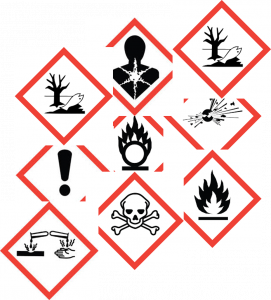Hazard Communication (Hazcom) Safety Training

Summary
Hazard Communication (Hazcom)
When hazard communication is implemented effectively, it has significant benefits for both the employer and the workers in a workplace. Employers need the information provided to them in order to assess the safety and health aspects of their workplace appropriately, and to select needed control measures for the chemicals that are present. The information provided on Safety Data Sheets (SDSs) may also be used by employers to select the least hazardous chemical available to accomplish what is needed in the workplace. Substitution of a less hazardous chemical benefits workers because they will not be exposed to the greater hazards, and benefits employers because they may have less need for controls in some situations. The information employers receive on labels and SDSs will help them meet requirements for a safe and healthful workplace.
- Learn the Standard/Identify Responsible Staff
- Obtain a copy of OSHA’s Hazard Communication Standard.
- Become familiar with its provisions.
- Make sure that someone has primary responsibility for coordination implementation.
- Identify staff for particular activities (e.g., training)
- Prepare and Implement a Written Hazard Communication Program
- Prepare a written plan to indicate how hazard communication will be addressed in your facility.
- Prepare a list or inventory of all hazardous chemicals in the workplace.
- Ensure Containers are Labeled
- Keep labels on shipped containers.
- Label workplace containers where required.
- Maintain Safety Data Sheets
- Maintain safety data sheets for each hazardous chemical in the workplace.
- Ensure that safety data sheets are readily accessible to employees.
- Inform and Train Employees
- Train employees on the hazardous chemicals in their work area before initial assignment, and when new hazards are introduced.
- Include the requirements of the standard, hazards of chemicals, appropriate protective measures, and where and how to obtain additional information.
- Evaluate and Reassess Your Program
- Review your hazard communication program periodically to make sure that it is still working and meeting its objectives.
- Revise your program as appropriate to address changed conditions in the workplace (e.g., new chemicals, new hazards, etc.).
Employee Information and Training. The key requirement is in paragraph (h)(1):(h)(1) Employers shall provide employees with effective information and training on hazardous chemicals in their work area at the time of their initial assignment, and whenever a new chemical hazard the employees have not previously been trained about is introduced into their work area. Information and training may be designed to cover categories of hazards (e.g., flammability, carcinogenicity) or specific chemicals. Chemical-specific information must always be available through labels and safety data sheets. (See training requirements below)
Hazard Communication Safety Training Resources
- What HAZCOM is and why it’s important
- Hazard classifications
- Safety data sheets
- What makes a chemical a health hazard
- Labeling
- 9 pictograms and their meanings
- Information and training
- Control measures
- …And more
Hazard Communication. – 1910.1200 _ OSHA
Training Requirements in OSHA Standards
OSHA 3491 Quick Card Pictogram